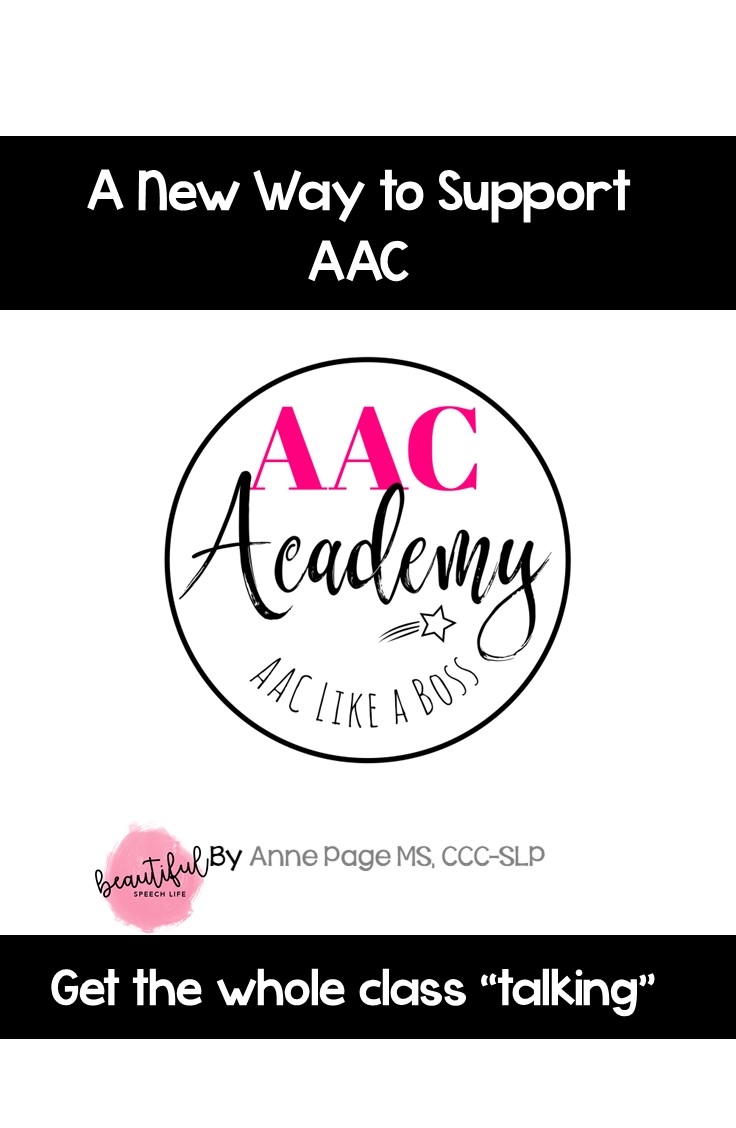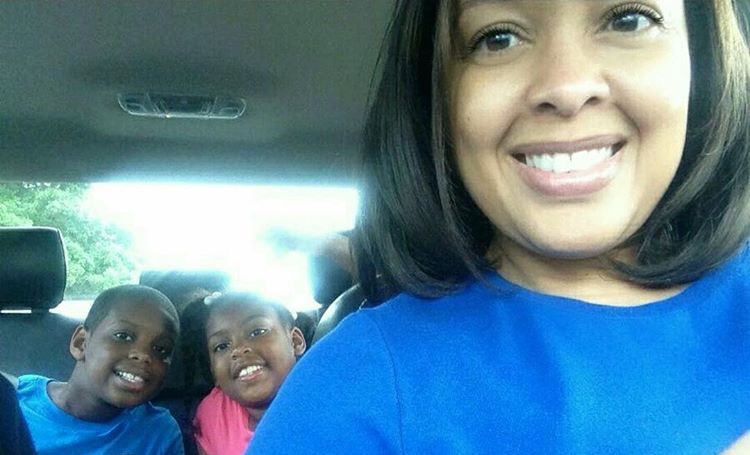
by Anne Page | Apr 21, 2017 | Autism
With April being Autism Awareness month, I thought this was the perfect time to do this interview. I’ve been following Nicky on Instagram for the past two years. She has an inspirational, positive feed (Nickys Day) showcasing her days as a mother of a child with Autism. Her son, MJ is 12 yrs old. I can tell from his photos that he has a loving, sweet disposition…that face!
So let’s jump right in. (I’m AP and she’s NB)
AP: Nikki it’s so great to finally speak with you, I feel like I already know you from your Instagram feed! Why don’t you go ahead and tell us why you started your blog.
NB: My son MJ is 12, he’ll be 13 in May. He’s funny sweet and loving. He’s an amazing kid. I’ll just be honest, I didn’t know a lot about autism when he was diagnosed. I’ve been blogging for two years, because now I can talk about it. I thought about how I felt and decided if I can help someone else then I’m going to do it I want to give other parents hope. There is light, they just have to hang in there.
AP: I feel like I’ve learned a lot about you listening to your interview on The Skinni podcast. There you talked about what it felt like when MJ first received the diagnosis of autism. Can you talk to us a little bit about that?
NB: The first time you hear it, you think your life is over. You think, why is this happening. I went into a shell, trying to process and accept. I let myself cry for a day and then it was time to move forward and help my son.
AP: How did you do that?
NB: I was doing research and wondered, did I miss something? But I knew I had to do what I could do. Looking back I didn’t reach out for help, I didn’t feel like anyone could understand. You feel helpless. But day by day it gets better.
AP: I am an SLP who works with many children who have autism. I’m so interested in your point of view (as a parent), about the IEP process and working with the school. Most SLPs participate in 60 to 80 IEP meetings every year. It’ll be so beneficial for us to hear what it feels like sitting on the other side of the table.
NB: This is the first thing I thought of when you asked me about doing the interview. Thinking back to when we were at MJ’s first IEP meeting…you all use a lot of terminology. Expressive, receptive, echolalia. I figured that one out because echo was in the word. But a lot of these terms were new to me. Social language, semantics, apraxia, syntax. And what does four out of 10 trials mean?
AP: I know, it’s a lot of information.
NB: MJ’s first SLP said to us, ‘he may never speak. And if he does it might not be intelligible speech.’ She explained the process well, but there was no hope.
A parent might be sitting in front of you nodding, but inside they’re thinking oh my God.
(Anne’s Note: You guys, this makes me cry! I want to make sure I offer hope and support to all the parents I work with.)
AP: As a mom, what would you like SLPs and special education teachers to know?
NB: Tell us what you actually do. We want to know what happens while you’re with our child, so we can implement it at home. I need to see it.
It’d be great to have a 20 to 30 minute training on this. Handouts explaining the terminology, so we can look at them at home. A weekly progress checklist or even a text. I know you all are busy and I know about the caseloads, I’m a middle school teacher myself.
If you don’t tell me, I don’t know. It’s not like he’s going to tell me. So many more things happen at school than they do at home. When we say our child is different at home, he really is. The MJ at school is not the MJ at home. To him school is for work, home is to relax.
You do start to feel Hope. Especially when the school shares his progress. One of MJ’s SLPs typed his first sentence and sent it to me. THOSE are the things that help you keep going.
AP: Now that MJ’s got his big 13th birthday coming up, what are your hopes for him when he goes to high school?
NB: I want him to be safe, continue to make REAL friends, improve in social skills, and continue to learn as much as he can. He’s a genuinely happy kid and I want that to continue. JOB SKILLS would be amazing as well.
I think I can speak for all of us when I say thank you to Nicky for letting us learn from her journey. I truly admire her for her candor, optimism, determination, grit and fierce love for her son.[spacer height=”20px”]
If you’d like to learn more about autism, look at these statistics from
autismspeaks.org:
- Autism now affects 1 in 68 children and 1 in 42 boys
- Autism prevalence figures are growing
- Autism is one of the fastest-growing developmental disorders in the U.S.
- Autism costs a family $60,000 a year on average
- Boys are nearly five times more likely than girls to have autism
- There is no medical detection or cure for autism
I hope you found this information helpful and inspirational. Every child needs a powerful, caring team of adults working together to empower him with education, love and knowledge.
Together we can change lives,
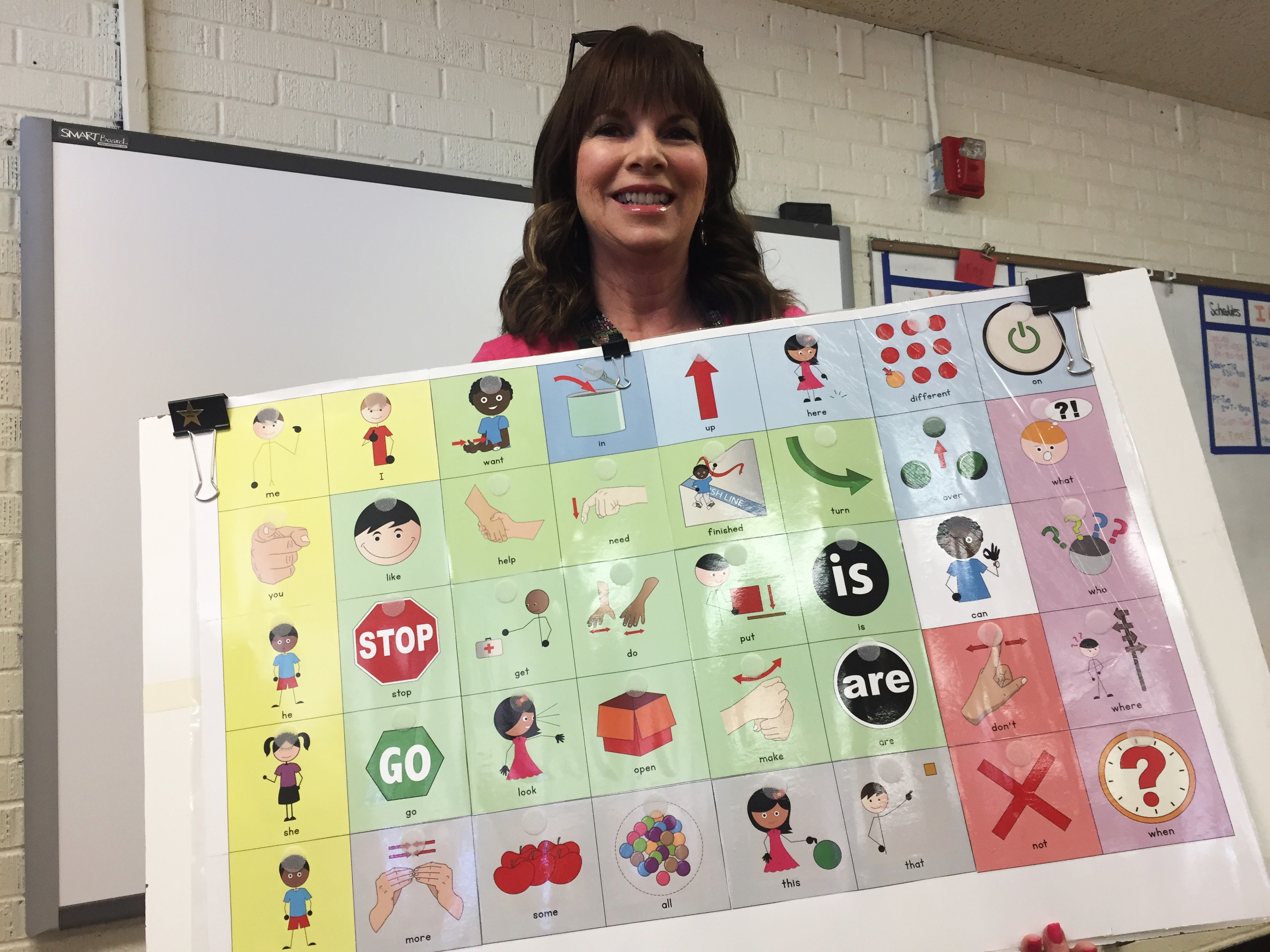
by Anne Page | Apr 6, 2017 | AAC, Autism, Therapy Ideas
Do you struggle with planning functional communication therapy?
Do you leave those sessions feeling frustrated and like it nothing is working?
I sure used to. And then I discovered the power of Core Vocabulary.
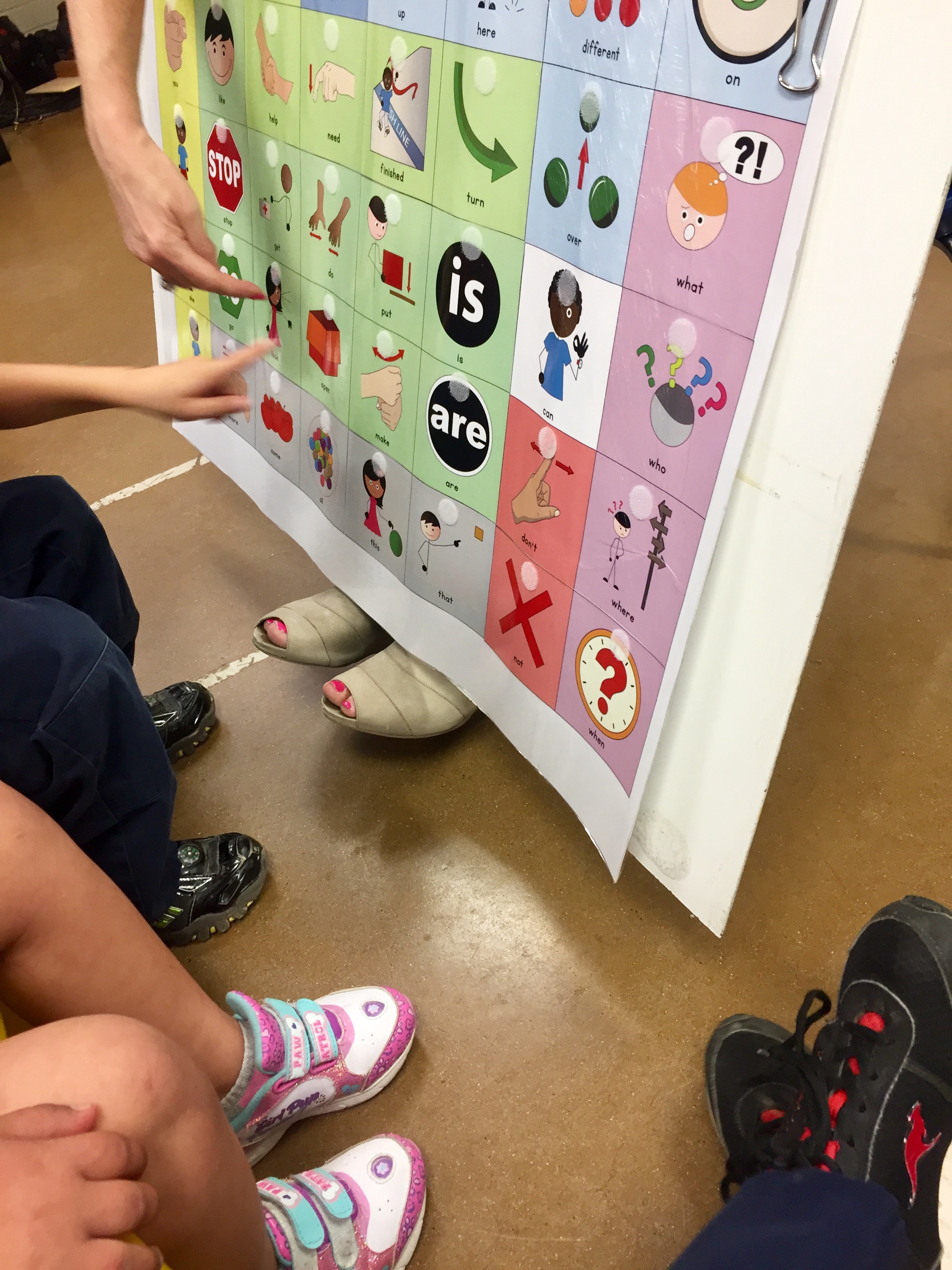
You can add structure, consistency and fun to your sessions by using Core Vocabulary. You’ll be amazed at how you can do more with less!
It’s not just for labeling. These words are used to comment, request and command.
Of course, you want students to learn many other words, these are fringe vocabulary. But by focusing on core words you are teaching them a vocabulary that is used most often throughout the day and that they can use throughout their daily lives from classroom to playground to cafeteria to home.
So what exactly is core vocabulary?
Core vocabulary is a small set of simple words, in any language, that are used frequently and across contexts (Cross, Baker, Klotz & Badman, 1997). These words make up 75-80% of the words we use every day.
I love to use big core vocabulary boards with my students. You can choose your core words from many sources and create your own board using symbols.
I just created this core vocabulary board. I spent months tweaking the size, the positioning of the symbols and using it with my students. Here’s what I love about it:
- Big squares are easy for little hands to grasp and large enough to see clearly.
- Made for classroom and/or speech room use
- Uses DLM Core Vocabulary words which are evidence based
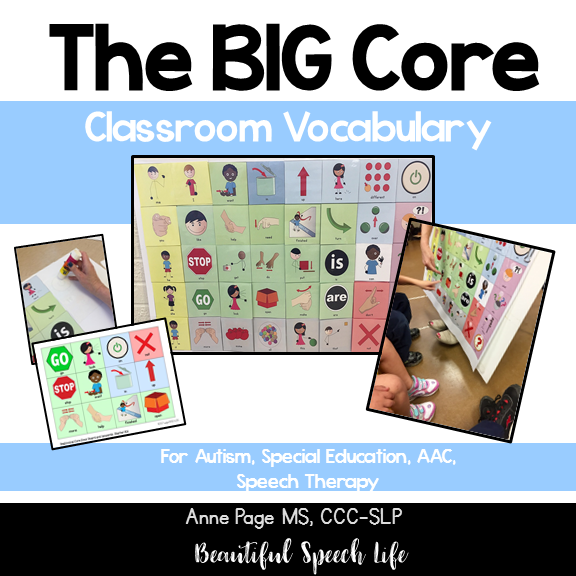
It’s available in my Teachers Pay Teachers store now. Included with the board are two different choices of backgrounds, one vibrant and one more subdued. There is also a smaller poster to put on the classroom door to help with carryover. And smaller squares to use for lanyards to encourage use of the core vocabulary words throughout the day.
If you’re sold on Core Vocabulary but wondering how to get started, I also included enough ideas to get you through a few sessions incorporating wind-up toys and movement.

Click on this link to see the Big Core Vocabulary Board.
Psssssst…April 7th only….This is at an Introductory Price of just $5.00 (I know are you kidding me? That’s a whole lotta resource, that will last a lifetime)
I hope this gives you a good start. I don’t teach core vocabulary for the whole session, but consistently work it in for 10 to 15 minutes of each 30 minute session.
Keep coming back, because I’ll be sharing more ideas on how to use core vocabulary to make communication gains. Also join me on Instagram, where I share lots of ideas in my Instastories.
I’d love to hear from you once you’ve tried this. How did it work for you? What new ideas did it generate?
Hugs and high-fives,

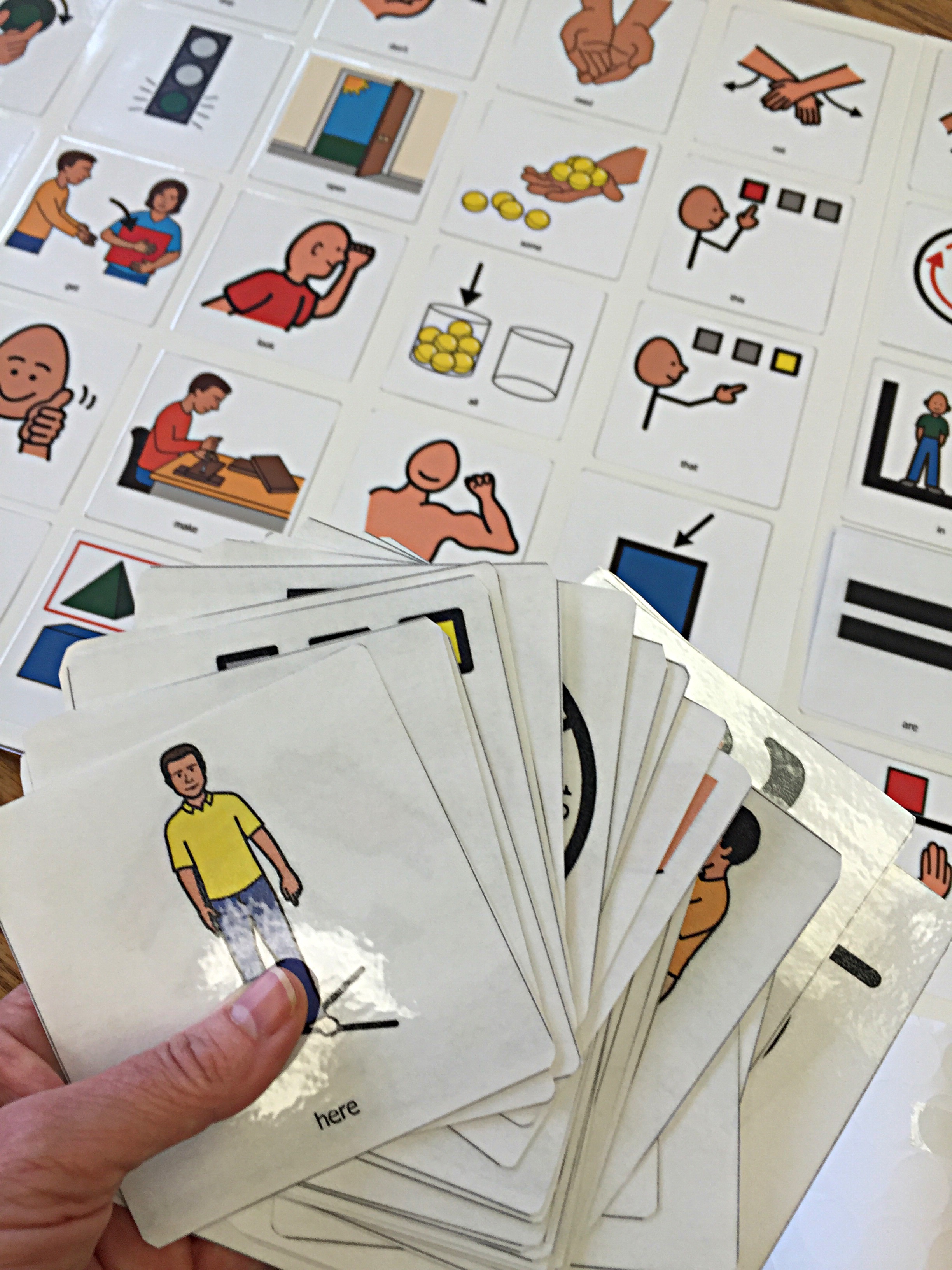
by Anne Page | Jun 13, 2016 | AAC, Autism, Therapy Ideas
Last week I shared 3 tips on how to AAC Like a Boss. They were:
- You don’t have to know everything
- Be Resourceful
- You don’t have to start high-tech
To continue along this line, today I want to talk a little bit about how I used all three of these tips to make a breakthrough for one of my students.
I’ve been doing group therapy with students who are working on functional communication for the past nine years. I don’t know about you, but I get really discouraged when my students don’t make progress. However, I think I was setting the bar too high too soon. Of course I want them to be able to communicate their wants and needs. There are just so many little steps to getting there; it can take a really long time!
This year I started using The Dynamic Learning Map Core Vocabulary; a list of 40 words that have been proven to be most effective socially and academically for students with significant cognitive disabilities. Developed at the Center for Literacy and Disability Studies at The University of North Carolina at Chapel Hill, these 40 words are based on AAC research.

My Core Vocabulary Board
This is both low tech and resourceful. Plus I really didn’t know everything about it, but I did do my research and know that it’s backed by evidence. I made a core vocabulary board for my room and decided to see what happened.
Let me tell you a little story to illustrate my point. I’ve been working with a little guy, let’s say his name is Benjamin (it’s not) for the last four years. Benjamin came to our school as a kindergartener with a diagnosis of Autism. He was nonverbal. His IEP from preschool had a following one step directions goal and an expressive language goal to “communicate his wants and needs using total communication”.
For the first two years, Benjamin had to learn to follow classroom routines and follow directions. His sensory integration needs were high and we were trying to figure out how to meet them. I felt like a total failure as an SLP. He didn’t say words, he didn’t use signs, and he didn’t have joint attention. He stayed in his own little world. But, he did learn to follow simple directions with visual and verbal prompts.
We have a little farm at our school and Benjamin was really interested in the animals. It was motivating and calming to him to be able to watch them. Soon he started labeling them. His parents bought him little plastic animals and taught him the names of over 100 animals. Progress, sort of. He still didn’t greet, comment, request or command. There was no joint engagement or joint attention. No pointing. He was just naming the animals for his own benefit. Not looking to see if we were listening, not wanting to share his discovery. If he couldn’t physically go get what he wanted, he would guide an adult’s hand to the item. Benjamin demonstrated echolalia and a lot of screaming.
Then we he was in second grade we taught him to request by labeling. We used beads, which he loves to roll and toy animals, which he loved to line up. I was able to get some eye contact by holding the item he wanted by my eyes. He had to look at me and say what he wanted. After a while, we (me, the paraprofessionals, the teacher and his parents) got him to add “I want” but he needed a verbal prompt each time.
Benjamin got an iPad with TouchChat that he was able to use but he hasn’t been too interested in it.
This past school year, he changed classrooms and it took a good four months for him to settle into the new routine. His communication progress was at a standstill. Actually, he even regressed.
I was so sad. I had just told his mom that I wasn’t making any progress with him in group therapy sessions. He was falling asleep, or hanging off of his chair or screaming; sometimes all three in one session. The other kids were so distracted. I made arrangements to see him for individual therapy for a while.
The next day, Benjamin’s teacher forget to tell the aides about the new schedule and they brought him to my room with the group. I said, okay let’s just try one more time.
I was introducing the new core vocabulary board I made and planned to teach the command “go’ through the use of the picture symbol. I set up a little miniature bowling game on the table. I noticed I had Benjamin’s attention, so I let him go first. Big Therapy Win! He participated with minimal prompts for the first time ever. He loved the Core Vocabulary Board with the bowling. In this picture, he’s waiting, holding the ball until we (his classmates and I) say “go”. We had joint attention, joint engagement with PEERS, and smiling. I wish I would’ve filmed it.

Therapy Win!
That was in January. Ever since then, he’s been participating. I keep the sessions really active with pop-up toys, wind-up toys and balls. So far he’s learned “go”, “stop”, “want”, “more”, and “I”. In April, he was able to put together this sentence “I want more go” using the picture cards and verbalizing. So exciting!

Core Vocabulary
What is it that worked? I believe it was a combination of timing, high interest activity and the Core Vocabulary visuals.
I am really looking forward to seeing what is the next step for my friend Benjamin.
So my point is…Patience Grasshopper.
We have to keep trying new approaches. I knew Benjamin was really visual and had tried some pictures before with little success. The Core Vocabulary words are immediately applicable and they can be used for fun, functional communication.
I really encourage you to try using DLM Core Vocabulary Words. As I learn more about this, I will definitely share the information with you all. I made a little cheat sheet and resource guide for you to help you get started. I know it can be a little overwhelming when you start out, so I streamlined it for you.
Until next time…SLP Like a Boss,
Anne
If you are looking for help with core boards, then download your condensed guide to core boards by clicking the green box. You’ll find links to popular AAC boards, along with tips to get started.


by Anne Page | May 3, 2016 | Autism, Blog, Language Activities, Therapy Materials and Ideas, TPT Products
Do you feel like you are aimless or not at the top of you game when working on prepositions?
I can totally relate. I work with a lot of special education students. I tried taking pictures of students under tables, in chairs, next to each other. They enjoyed the activity but it didn’t stick.
I tried having them take turns putting a fun toy on the chair or taking it off the chair. Again fun, but not getting the concept.
I tried it with matching puzzle pieces, with apps, and games. Still no lasting success.
Talk about feeling like a Bad Therapist.
But I kept trying.
Then a combination of learning experiences came together. I noticed that teaching opposite prepositions didn’t work. I noticed that kids got distracted by little details in pictures. I went to an amazing presentation by Dr. Elena Plante, research SLP from University of Arizona and she talked about the importance of errorless learning and teaching one concept at a time.
I learned about fast-mapping. Fast mapping is the psychological term for learning a new concept after a single exposure to information.
Students with SLI and cognitive impairments are not able to fast-map like their typical peers.
So….
I tried making a book with simple visuals and white background. This way the focus was only on the relationship of the objects to each other.
There is a picture strip with words at the bottom of the page, always the same “Where is the _____”(object) The next page always has ______ (target preposition) the ___________ (relationship word).
Object remains the same. For example in “The Under Book” the object is always a banana, it is always under something. Going through the book once gives 12-15 repetitions.
The other important piece is that the skill needs to be taught in more than one setting. So with all of the prepositions books I offer examples for how to extend the new concept into different settings.
I’m still doing more investigating in this area but I can say, I’m having good results with these books. So are the people who have bought them.
” I am so excited about this book! I have several students who are working on positional concepts and it just takes so many repetitions to learn the concepts. I love that this book is full of repetitions. I am looking forward to more in the future!” ~Buyer
Here is the new “Next To Book”. This completes the first three prepositional concepts that children with typical language development acquire at the age of 3: “on” and “under” and “next to”. I’ll be working on the next ones soon.
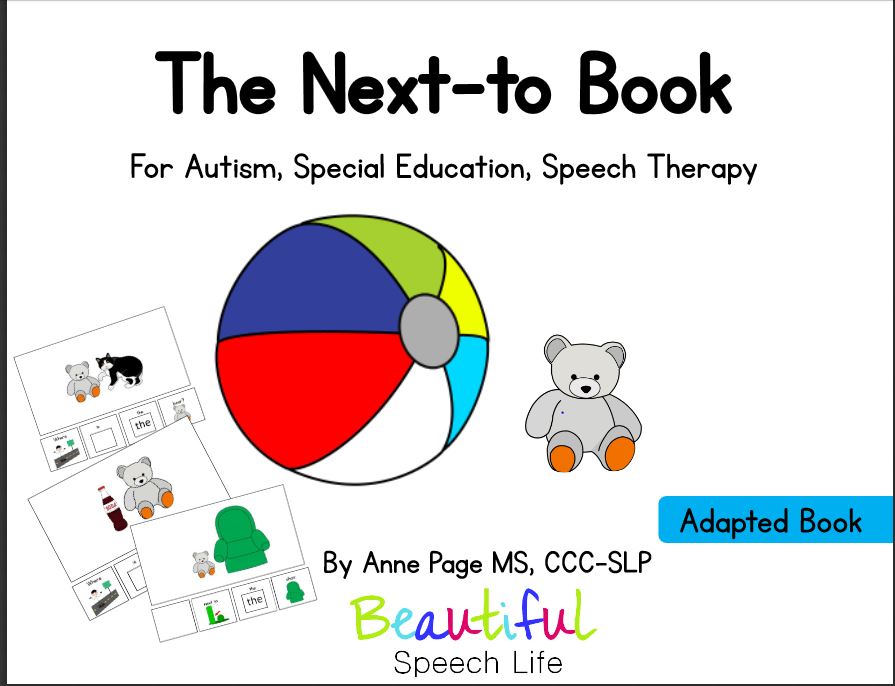
While I was doing my research, I put together this handy little chart. This will be great as a parent/teacher handout and just to keep for your own reference. I’m giving it to you for FREE, just click here. As a Beautiful Speech Life follower, you are getting it early! I already gave it to my TPT followers, but if you missed it, here it is again. I’ll be putting it in my TPT store later. (It’s also included in The Next To Book)
So take charge of those prepositions and SLP Like a Boss,
Anne
P.S. Did you like this post? I’d love it if you’d share it with your friends. Subscribe at the bottom of this so you don’t miss any of the fun.

by Anne Page | Mar 14, 2015 | Autism, Inspiration

(Note: I found this in a tucked away journal. It was almost written two years ago when I was doing some of my clinical experience for my master’s degree.)
May 2012
Hugo doesn’t speak. When I first saw him he had a lot of physical ticks and throat clearing. He loves the iPad. My strategy was to gently move into his space physically and match his energy. He is quiet and there is a sweetness about him. For the first few sessions I sat next to him on the couch. My supervisor, had been working with him and would say “my turn”, take the iPad and model a sound. When he made a sound (any sound), he got the iPad back. So I started there. Hugo likes to play animal games, especially animal puzzles. I would consistently say the name of the animal as it was on the screen. With time, Hugo would look up each time for eye contact and a smile. I started signing the animal name along with saying it. Hugo started imitating the signs.
This became our routine. Hugo was starting to make a few different sounds but still routinely says “t”. One day, after 35 minutes of our 45 minute session, he turned off the iPad and started to leave. I followed his lead, figuring he either needed to go to the bathroom or go swing in the jungle room(he had OT after our session). He started to run, but I held his hand and gently said “no running, let’s walk, hold hand”. He lead me to the swing. He was swinging for a while, looking at the colorful animals painted on the walls. I followed his eye gaze and signed the names of the animals. When he finished swinging, he stood up and hugged me. That was a first. He had held my hand before but never initiated a hug! I think it was a sign of affection and thankfulness.
One month later…
We were having our usual session of Hugo looking at the iPad and making animal puzzles. After 35 minutes he closed it and was ready to go. I said 5 more minutes but he wasn’t interested. Again, I followed his lead because I had a hunch that he wanted to go back to the jungle room. He wanted to run again (we didn’t). When we got there, he pointed to the large elephant and said “t-t” and looked at me. I signed it for him and he had a big smile. He did that with each animal (pointing and smiling, not just looking). I really got the feeling that he was making the connection for the first time between the animals in the iPad puzzles and the animals on the wall! Generalizing is so hard for children with Autism. It was so exciting to be able to witness that realization on his face. For a second, I felt like Anne Sullivan.
The following month:
Hugo was consistently imitating signs for animals!
Sometimes, we have to let go of our treatment plans. We have to remember that children with autism process and absorb information at a different pace than we do. If you can be patient and gently join them at that pace, they may surprise you.



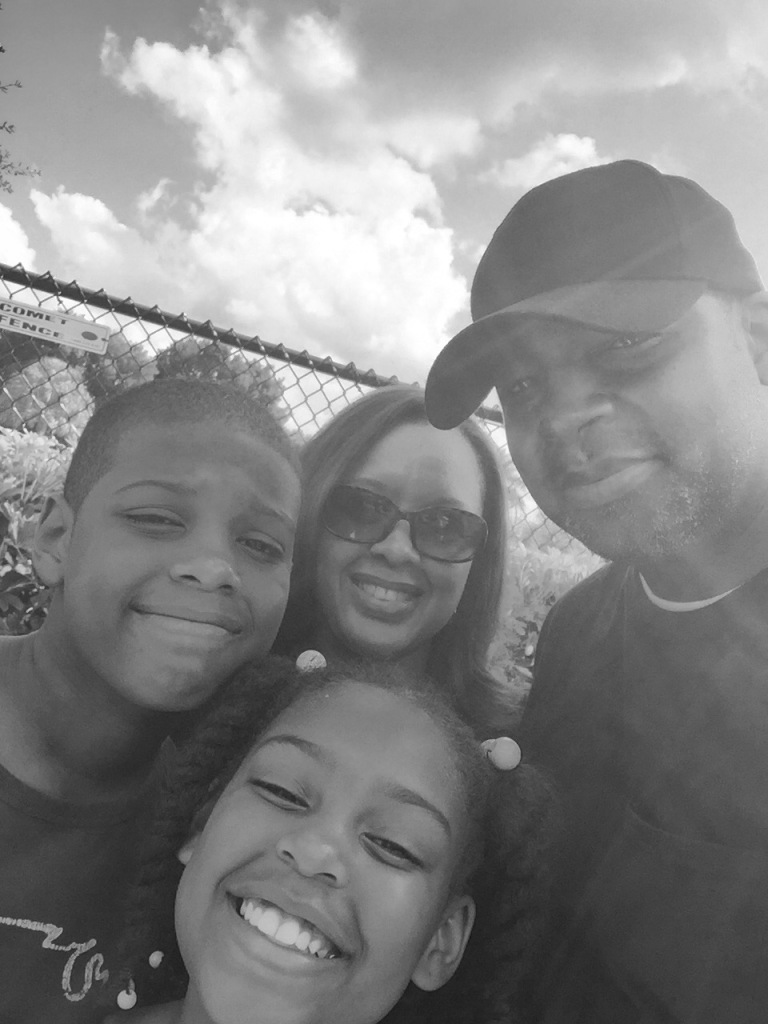











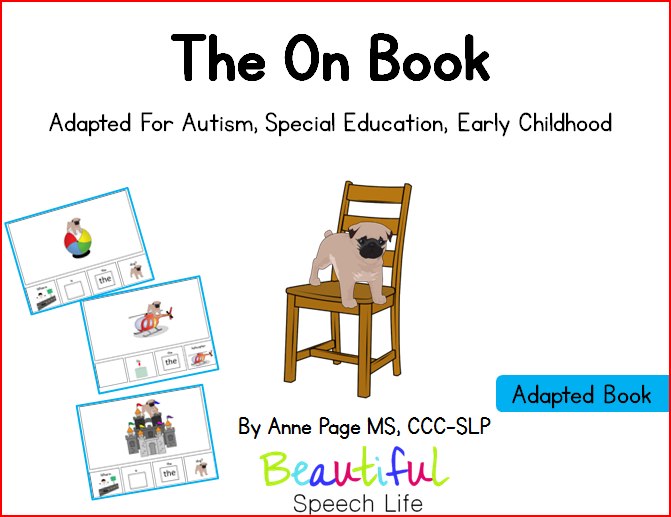


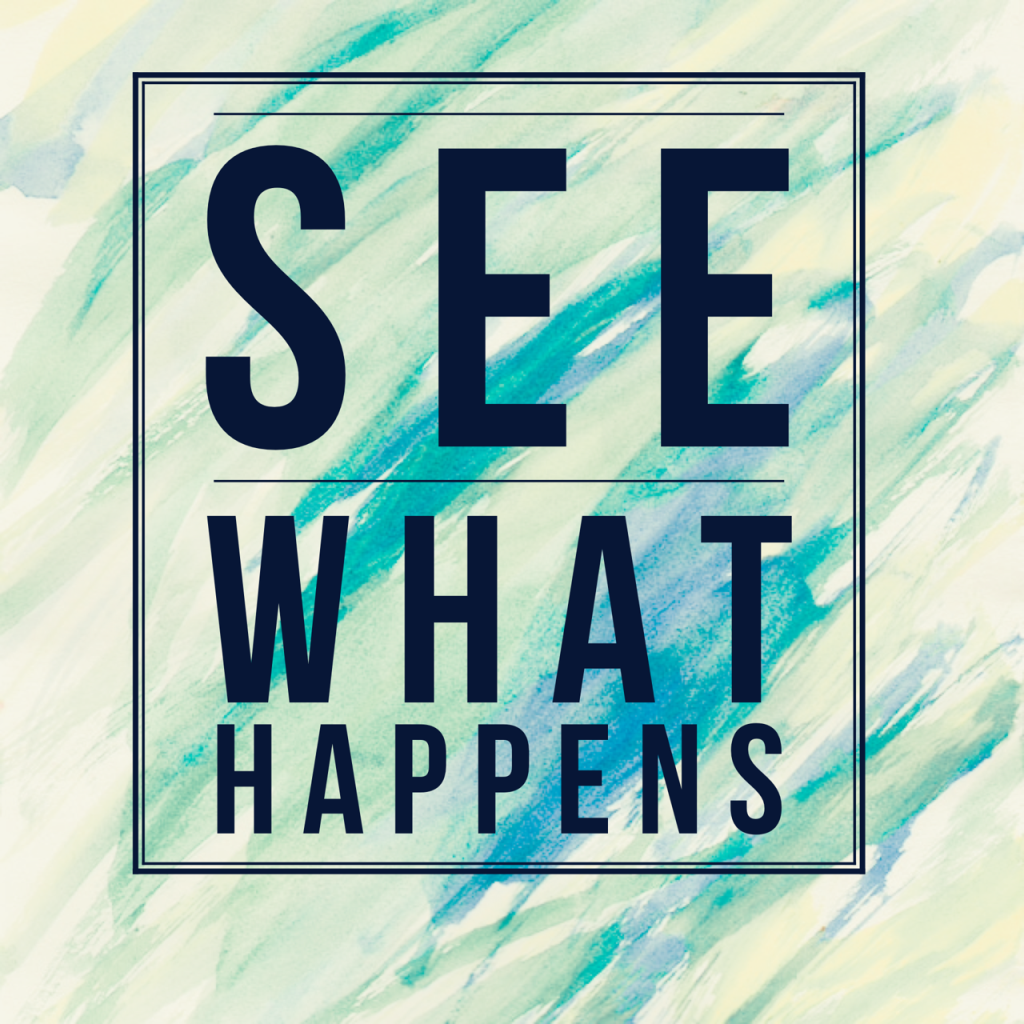
 Hey there I’m Anne Page. I help heart centered SLPs and educators put the fun in functional communication.
Hey there I’m Anne Page. I help heart centered SLPs and educators put the fun in functional communication. 